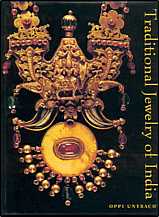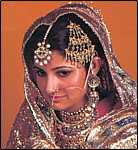Traditional
Jewelry of India
By Oppi Untracht
Harry
N. Abrams, 432 pages, approx. 870 illustrations, incl. 220 in full color,
9 x 11 ľ, Hardcover
Buy
Online
Reviewed by Nancy Lyons
Traditional Jewelry of India is the first book to catalogue Indian ornament, which celebrates both the human body and spirit, as an ongoing aesthetic tradition spanning at least 5,000 years. Oppi Untracht has spent more than thirty-five years researching and collecting the major jewelry designs and techniques of India. The result is a comprehensive book which examines the ancient mystical and religious beliefs and the social, economic, and political factors that influenced the construction and presentation of Indian jewelry. As a form of cultural expression, this jewelry represents the many ethnic groups and levels of societies that still exist within India. Itís so diverse that the chart of traditional Indian Jewelerís tools and materials consist of terms translated into English, Hindi, Bengali, and Tamil.
 |
| photo by Maurice Aeschimann, Geneva |
Mr. Untracht follows the natural pattern of human cultural evolution to trace the development of Indian ornament. Richly symbolic body decoration and markings of remote Indian tribes hold the key to its origins. He tells us that the use of rosaries, which passed from the Hindus to Buddists before it reached the Christians around 11th to 13th century A.D., is still practiced by major Indian religions today.
The author explains that the early interest in the "magical" powers attributed to hardstones, found on vast deposits in India, prompted an entire industry for ornamental and religious pieces. Even today, amulets continue to give the wearer a consoling sense of protection, as well as a feeling of identity with his community. Extending this idea, marriage jewelry in modern times, as in the post, not only protects the wearer, but conveys the status and social role of the bride. It may also indicate the wearerís geographical place of origin, religion, and caste.
Mr. Untract explains that gold, often the primary metal used is considered to have maximum spiritual potency. Other vernacular adornments covered include immense temple treasures, theatrical jewelry and colorful decorative pieces for honored animals such as horses, camels, or elephants.
 |
| photo by CK Kamkar, Air India Art Studio, Bombay |
In another chapter, a pictorial overview of traditional Indian jewelry is grouped together by its use on the body, from head to toe. This approach highlights the numerous places one can decorate, such as the top, side and back of the head. The section on rings covers everything from the signet ring, a symbol of power and purpose; to the "arsi" ring, a small round mirror worn by women on the right thumb for admiring oneself; and the cleverly designed artherís right thumb ring, made for accuracy and aiming at the longest distance.
The author devotes more than a few pages to the use of gold and silver, and the jewelry trade as it is conducted in India. He explains the history of the Indian goldsmith, and distinctive techniques like the granulation process, used even today. The discussion of Hindu cosmology is helpful, especially since it distinguishes gemstones and their uses.
Probably the strongest influence on traditional jewelry designs happened during the Mughal Dynasty from the 16th to 19th century. Through imperial sponsorship, artisans were given the opportunity to extend their creative capacities. Stunning gold necklaces with rows of pearls, rubies, emeralds and unusually cut diamonds were made for the Mughal emperors. Supplemented with interesting historical quotes, this section allows the reader to really appreciate the quality of jewelry produced by the Mughal court craftsmen.
Perhaps of most interest to jewelry historians, by the end of the book one realizes a distinct cross-cultural exchange between East and West in jewelry design and technique. Euro-Indian introductions include the cameo, miniature portrait painting, and claw settings for gemstones. Early 20th century Indo-European design reflects Indian influences with the popularity of multi-strand pearl necklaces, chokers, the use of sarpech-aigrettes, and swami jewelry. Convincing illustrations show how top jewelry designers such as Guiliano, Tiffany and Cartier incorporated Indian motifs into their creations. The author asserts that even the use of multicolored carved stones in Arts and Crafts and Art Deco jewelry can be attributed to the Mughal tradition.